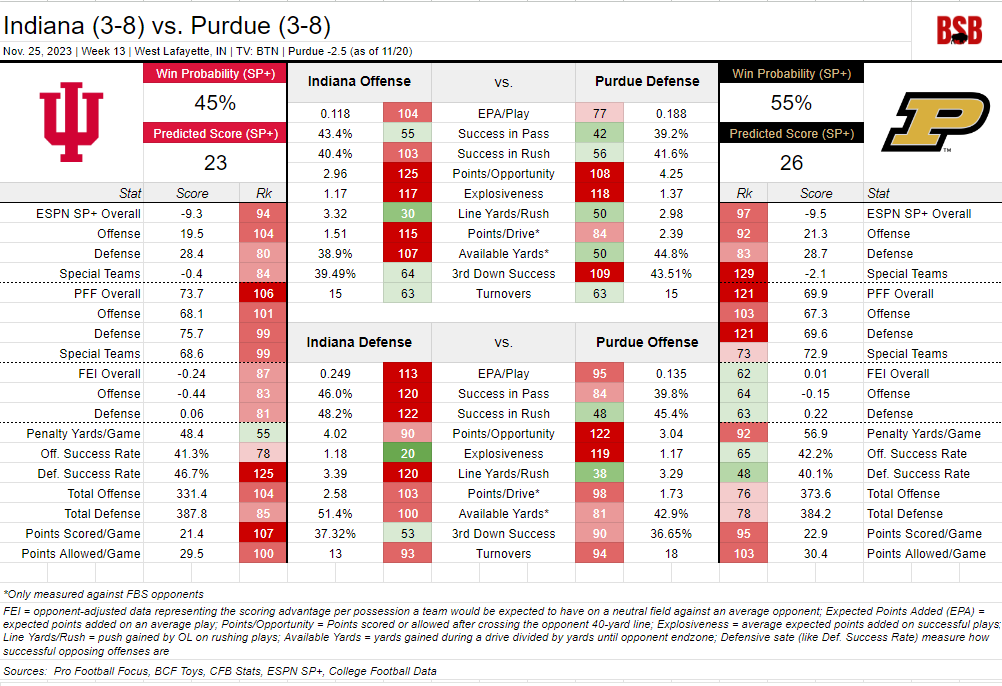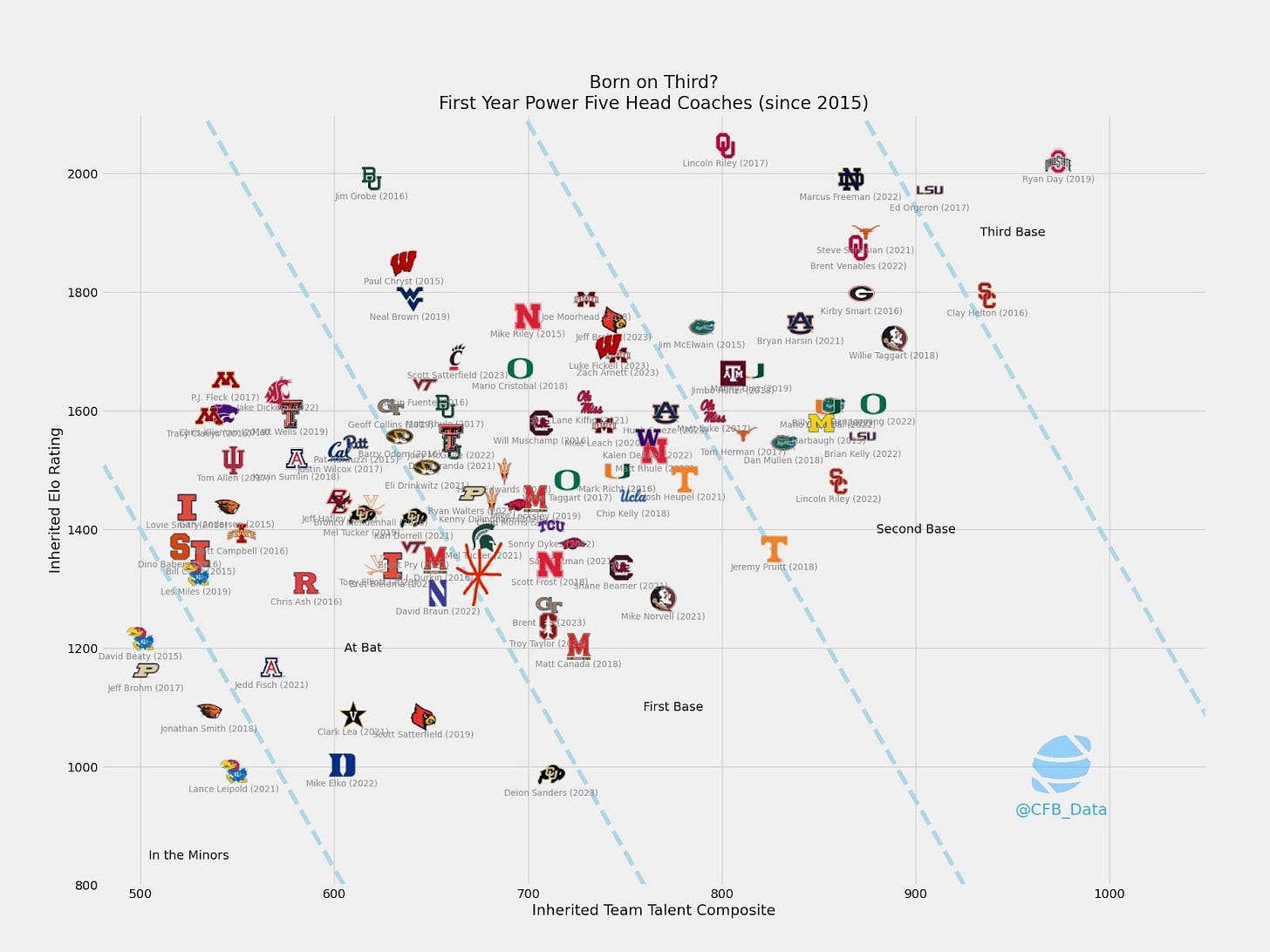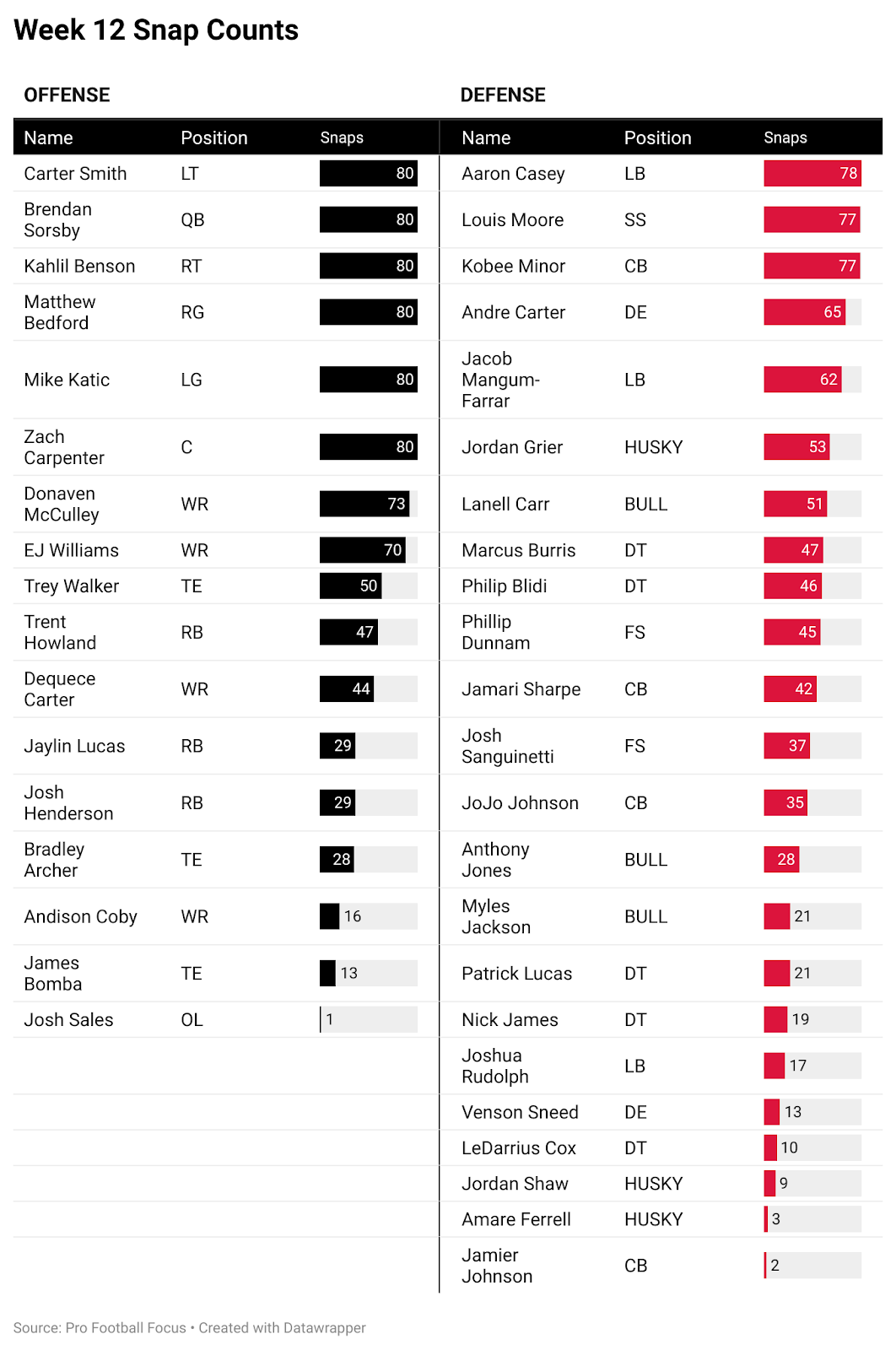Week 13: Purdue
Recapping last week's loss to Michigan State and previewing the season finale at Purdue
Statistical Preview
Keys to the Game at Purdue
As you will read below, field position has been an issue for Indiana (and was against Michigan State as well). Purdue’s offense has turned the ball over 8 times in its last four games and ranks 94th in the country in turnovers. Can Indiana force a turnover and flip the field for its offense?
Indiana has converted decently on third-down for most of the season, which has resulted in some sustained drives. They’ll need to do so in West Lafayette, especially to keep an upward-trending Purdue offense off the field.
Under Rod Carey, Indiana’s rushing success rate has improved from 33.5% to 40.4%, and since Week 6 (the bye week Carey took over). Indiana ranks 12th in the nation in line yards per rush. He’s going to want to run, and Purdue has allowed some massive rushing performances (271 yards, 5 TDs to Syracuse; 195 yards, 4 TDs to Wisconsin; 5.2 yards per carry to Iowa). However, Purdue has allowed more than 3.9 yards per carry just once in its last five games. Brendan Sorsby running the ball could be a factor (see below).
Indiana must stop Tyrone Tracy. The Indianapolis-native RB played at Iowa as a WR (the position he was recruited for) for four seasons (including a redshirt year) before transferring to Purdue to play RB. In his last year, he’s playing better than ever, as he leads all Big Ten RBs (100+ carries) in PFF’s rushing grade, as well as yards after contact per attempt (4.44), breakaway yards percentage (48%), and elusiveness rating (170). He’s coming off two 100-yard games in which Purdue totaled more than 300 rushing yards in each, and the former WR has the third-best receiving grade among Big Ten RBs. He’s going to be a problem.
Indiana’s secondary was certainly exposed two weeks ago against Illinois when it allowed 507 passing yards to Illinois backup QB John Paddock. Last week, against Michigan State, Indiana allowed the lowest-graded QB in the nation (Katin Houser) to throw for a career-high 277 yards. With as strong as Purdue’s running game has been, the secondary must not allow Hudson Card (98th in the nation in QBR, 12th in the Big Ten) to pass on it. That would be a dagger.
Indiana’s Talent and Performance under Tom Allen
Bill Radjewski of CollegeFootballData.com posted a chart that compared Elo ratings (essentially the quality of the team) to the 247Sports Team Talent Composite rating to visually display the quality of each program the year before a new head coach took over (since 2015). I adjusted that chart to show where the program currently stands for Tom Allen, if this is in fact his last year in Bloomington.
Note: Indiana currently (2023) sits where the red asterisk is located in the chart above.
This also inspired me to create a separate chart to depict each year of this comparison within the Indiana program, dating back to the year before Kevin Wilson assumed head coaching duties and through 2023.
Note: 247Sports’ Team Talent Composite only goes back to 2016.
Some takeaways:
Obviously, the drastic disparity between talent and performance 2021-23.
Quantifying talent is extremely difficult, but this is how 247Sports describes its Composite Rating, which is central to the composition of the Team Talent Rating: “The 247Sports Composite is a proprietary algorithm that compiles rankings and ratings listed in the public domain by the major media recruiting services, creating the industry's most comprehensive and unbiased prospect and team rankings.” It offers more info on composite ratings here. It’s an imperfect metric, but it does a decent job of showing potential on the roster.
It is still very early in the portal and NIL era, but early indications show the portal and (potentially) NIL are actually helping Indiana maintain a talent level not equal to the quality of the teams Indiana has put on the field.
Related to the last point: Using the portal to maintain mass talent is not a great strategy, as we’ve discovered this season (see the chart beneath this bulleted list). Building a roster is more than just talent; it’s also continuity and developing players within a consistent system – program-wise, offense- and defense-wise, position-wise. These are ideas I’ve mentioned several times in Bite-Sized Bison, so I won’t go deeper into that.
Tom Allen has done a quality job of building talent within the program. In recent years though, developing and maximizing that talent has been a bit of a struggle.
Indiana’s talent composite dropped between the 2022 and 2023 seasons, the first time this has happened since 2016-17 – the offseason of the head coaching change. Now, the talent composite is nearing the level it was when Kevin Wilson left the program.
Source: @jbuddavis on Twitter
Note: Indiana should also receive an arrow from the “It’s tough to portal a defense” box on the chart.
Where Did Indiana’s Offensive Success Go Against MSU?
Indiana ended Saturday’s 24-21 loss with an impressive 51% offensive success rate, according to CollegeFootballData.com. That rate is in the top 17% of all offensive performances this season and nearly matched Indiana’s 55% success rate against Indiana State. This is in addition to other impressive offensive metrics – top 25% in EPA/play, top 12% in EPA/rush, top 33% in third down success rate. Yet, Indiana scored just 21 points. How does that happen?
Well, largely, field position. Indiana didn’t start a drive with fewer than 72 available yards (its own 28) and averaged starting at its own 18 against Michigan State. Considering that Indiana ranks 94th nationally in total opportunities (drives that cross the opponent 40-yard line) and ranked 126th in available yards gained before the opponent 40 after Week 11, it’s impressive that the Hoosiers turned that field position into 6 opportunities. They averaged 52 yards per drive and gained 64% of available yards – both impressive, particularly for IU – but if you’re gaining 52 yards per drive and only gaining 64% of available yards, it’s a sign that getting into the endzone will be that much tougher. That’s why forcing turnovers is so crucial to feeding an offense, if you’re a defense-first team.
Field position hasn’t been stressed as much as it should be with this Indiana team. The Hoosiers rank 121st in average starting field position (108th since the OC change), and each of their 22 touchdowns this season have required an average offensive gain of 68 yards (average start at IU’s 32-yard line). These field position woes can be attributed to all three phases – 124th in punt return yards per opportunity (2.94), 100th in available yards allowed (51.4%), and 107th in available yards gained (38.9%). Throughout the season, Indiana’s drives have stalled so early that James Evans’ 19th-ranked yards per punt (45) either haven’t pushed opposing offenses deep enough into their territory or they haven’t mattered, as Indiana’s defense has been but a thin membrane of resistance all year. Jaylin Lucas (and company)’s punt return struggles haven’t helped matters, though Lucas should be given credit for his kickoff return efforts, which are graded 14th in the nation as he remains the most dangerous kickoff returner in the Big Ten.
Now, as the offense has grown from a dismal 38% success rate to a slightly less dismal 41.3% since Rod Carey assumed OC, its success is being lost to the middle of the field, as we saw Saturday.
Brendan Sorsby Can Move
Brendan Sorsby should absolutely pass into this Purdue defense because, since taking over as starter in Week 8, he owns the 16th-best passing grade in the nation among QBs with at least 180 dropbacks. He can throw with most QBs at the Power 5 Level.
But Sorsby’s legs have become a significant aspect of the Indiana offense. Coming into the season, Indiana’s QB was expected to run, which given Sorsby’s high school career (where he was like a RB who could throw) made me believe he would eventually be the guy for this offense if it wasn’t Dexter Williams. Well, in the last two weeks, he’s set career-highs in rushing yards, with 53 and 59 yards. His successful runs have often come with sparks in energy as well – I loved him getting in an MSU defender’s face after the targeting penalty.
Sorsby has carried the ball 53 times, and of the 48 QBs nationally to run 50+ times, he isn’t graded particularly highly, but he’s also is not asked to be a true running QB.
In the 5 weeks since he was named the starting QB, Sorsby is the best rushing QB in the Big Ten. He leads the conference’s QBs in the following rushing categories: rushing yards (194), rushing TDs (4), yards after contact (126), missed tackles forced (15), carries of 10+ yards (7), and rushing first downs (17). Nationally (105 qualifying QBs), he’s 4th in missed tackles forced, tied for 4th in first down runs, tied for 5th in rushing TDs, 12th in yards after contact, tied for 19th in carries of 10+ yards, and 23rd in rushing yards.
There are generally two ways QBs run the ball – scrambling away from pressure and running designed rushes, as Indiana fans notoriously understand from the two designed QB draws to send the Illinois game into overtime. Thanks to the OL improvements, Sorsby is being pressured the third-least in the conference, and when he is pressured – no matter how ugly it might look at times – he is graded 6th in the conference and 3rd when rushing out of pressure. However, he scrambles out of pressure more than any other QB in the Big Ten. His 18 scrambles have resulted in 92 yards (5.1 yards per carry), and his 11 designed carries have resulted in 102 yards (9.3 yards per carry).
Also, remember Rutgers QB Gavin Wimsatt, who ran for 143 yards against Indiana? He has run for 97 yards in Rutgers’ three games since.
Purdue hasn’t been tested too often by running QBs, but when it has, it hasn’t exactly excelled. Against a few of the most capable rushing QBs in the conference – Heinrich Haarberg (Nebraska), Luke Altmyer (Illinois), and Tanner Mordecai (Wisconsin) – Purdue allowed 4.8 yards per carry (162 yards on 34 carries). Against Syracuse, Purdue allowed Garrett Shrader to rush for 208 yards, which is nearly half of his season-long rushing total (423).
Sorsby will most likely need to be dangerous with his arm and legs to win Saturday.
Notable Snap Counts against Michigan State
Jamier Johnson got into the Michigan State game for a couple snaps for the first time since Week 3. Seems like he will redshirt this season, since he hasn’t used it yet. Could result in two more years at Indiana.
Josh Sales has gotten in for some snaps here and there. It’s because when Indiana runs power sets, they put Sales in as an extra OL.
Jordan Grier earned his highest snap share since Noah Pierre was injured against Rutgers. Jordan Shaw was primarily at Husky the two weeks before, and Indiana shelved the Husky in favor of Anthony Jones at Bull against Penn State.
JoJo Johnson earned a decent snap share after allowing the big touchdown on his only snap against Illinois. Seems like Indiana is getting Johnson, Rudolph, and Sneed snaps to be more field-ready next season.









Tom Allen is a nice guy, but I think we can see from the trend line of this game IU had no chance to hang onto a 10 point 4th quarter lead. The playing for a field goal late was emblematic of the conservative play calling that doomed this team.
I’m reading this Saturday morning of the Bucket game. This is a good to great preview of the game. Thanks for all the work Tyler.